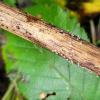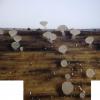
06-12-2025 00:19
 Viktorie Halasu
Viktorie Halasu
Hello, would anyone have this article, please? An

05-12-2025 17:33
 Bruno Coué
Bruno Coué
Bonjour, je serais heureux de recueillir votre avi

02-12-2025 18:59
This pair of ascos 2.5cm across were on recently b

02-12-2025 19:25
Buckwheat PeteHello, can anyone identify this hairy fungus growi

30-11-2025 12:53
 Edvin Johannesen
Edvin Johannesen
White short-stipitate apothecia found on thin twig

30-11-2025 10:47
 William Slosse
William Slosse
I recently found a collection of small Peziza sp.
• Confirmed by excipulum, etc.
• Receptacle also noticeably tough in sectioning and slide preparation.
• Spores suggest C. paludosa (with croziers).
Habitat: On a dead stem of Heracleum sphondylium, +/- standing, seems to have grown this year, damp and shady area, amongst herbaceous plants at the edge of a path, mixed deciduous woodland, Low Weald, England, early September, after lots of rain.
Spores: 12-14.6 (15.6) × 2.4-3 µm.

From what you've said and this description, it seems possible that Velenovsky was collecting both species but gave a mixed description as a single species. I wonder if he was aware of C. (Phialea) starbaeckii and the similarities with his taxon?
I would think that the species I found has been found in Europe many time before, but perhaps it has been confused with other Cyathicula species. It may be more challenging to clearly distinguish dead material too.


 Micro-0001.jpeg
Micro-0001.jpeg